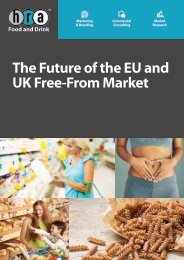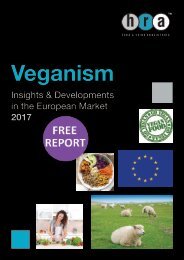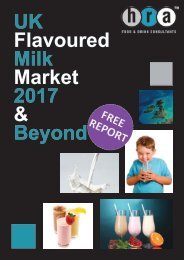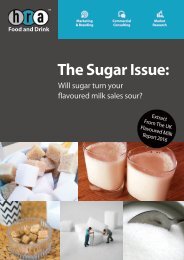FREE-UK-Flavoured-Milk-Report-2016-2017
The backdrop to the UK flavoured milk market is one of relentless change. The removal of the EU milk quotas, the transition to a Western-type diet by emerging economies, the UK sugar debate and the booming sports nutrition industry are all aspects of change that create both challenges and opportunities for the UK flavoured milk market. HRA Food and Drink Marketing has developed this report as a map to guide industry stakeholders. Although volume growth in 2014 was slightly lower than in previous years, the flavoured milk market still has plenty of room for product innovation and development. Overall, we expect the UK flavoured milk market to continue to grow over the medium term, but not without improving its nutritional profile. The sugar debate reached new heights when, in October 2015, Public Health England released a document suggesting Government intervention in the form of a sugar tax (levy). As a consequence, product reformulation has become a priority for all serious players in the market.
The backdrop to the UK flavoured milk market is one of relentless change. The removal of the EU milk quotas, the transition to a Western-type diet by emerging economies, the UK sugar debate and the booming sports nutrition industry are all aspects of change that create both challenges and
opportunities for the UK flavoured milk market.
HRA Food and Drink Marketing has developed this report as a map to guide industry stakeholders. Although volume growth in 2014 was slightly lower than in previous years, the flavoured milk market still has plenty of room for product innovation and development.
Overall, we expect the UK flavoured milk market to continue to grow over the medium term, but not without improving its nutritional profile. The sugar debate reached new heights when, in October 2015, Public Health England released a document suggesting Government intervention in the form of a sugar tax (levy). As a consequence, product reformulation has become a priority for all serious players in the market.
You also want an ePaper? Increase the reach of your titles
YUMPU automatically turns print PDFs into web optimized ePapers that Google loves.
<strong>UK</strong>#FLAVOURED#MILK#<strong>2016</strong>217#<br />
#<br />
an opportunity for small dairies to innovate or enter the flavoured milk<br />
market.<br />
3.11 Alternative Sourcing<br />
Country: Dubai, United Emirates<br />
Brand: Camelicious<br />
Flavours: Plain, Strawberry, Dates,<br />
Saffron and Chocolate<br />
Launch date: 2010<br />
What’s special? It is a nutritious and<br />
innovative type of milk that has been<br />
enjoyed for centuries: camel’s milk.<br />
•#<br />
•#<br />
•#<br />
•#<br />
To Gain Access<br />
As has been the case with alternative flavoured milk, we expect <strong>UK</strong><br />
consumers to be more open Purchase to trying flavoured The Full milk<br />
from origins other than cows. One example is Camel milk, recently<br />
<strong>Report</strong> Now<br />
launched in the <strong>UK</strong> under the Camel <strong>Milk</strong> brand.<br />
Its historic consumption can be traced to an Ethiopian valley where there<br />
is a group of nomads who eat camel meat and drink its milk. Camels are<br />
animals that do not require high levels of husbandry and yet produce vast<br />
quantities of milk.<br />
Camels’ milk is close in composition to human milk, has a more subtle<br />
flavour than goat and sheep milk and there is some research to say it can<br />
help treat a variety of diseases including diabetes, IBS and hepatitis. It<br />
contains just 2% fat and contains no beta-lactoglobulin and a different<br />
beta-casein to cows’ milk. As these are two components of cows’ milk<br />
which commonly cause allergic reactions, camels’ milk offers a viable<br />
alternative for some allergy sufferers.<br />
3.12 Consumer Targeted NPD<br />
•#<br />
•#<br />
•#<br />
•#<br />
The white liquid milk category has traditionally been one with minimal<br />
innovation. Looking at cow’s milk in particular, the key innovation which<br />
has added some value into the category has been filtered milk. Arla’s<br />
Cravendale is the biggest brand in <strong>UK</strong> filtered milk and is also the largest<br />
brand in the <strong>UK</strong> milk market as a whole.<br />
Although filtered milk accounts for around 5% of the total milk market,<br />
there are virtually no flavoured To filtered Gain products Access available. This is likely<br />
down to the limited number<br />
Purchase<br />
of processors<br />
The<br />
with<br />
Full<br />
the appropriate kit.<br />
Arla launched their Big <strong>Milk</strong> product which is aimed at the specific<br />
nutritional needs of toddlers between <strong>Report</strong> one Now to five with added vitamins A<br />
and D, iron and calcium. It is marketed on being a follow-on from formula<br />
milk and on allowing children to enjoy the nutritional benefits and taste of<br />
fresh cow’s milk.<br />
Following this, in January <strong>2016</strong> Arla also launched their Best of Both milk<br />
which tastes like semi-skimmed milk while being fat free.<br />
# 47#<br />
All rights reserved, ©Teepee#Ltd,#t/a#HRA#Food#&#Drink:#<strong>2016</strong>#<br />
to#<strong>2017</strong>#







